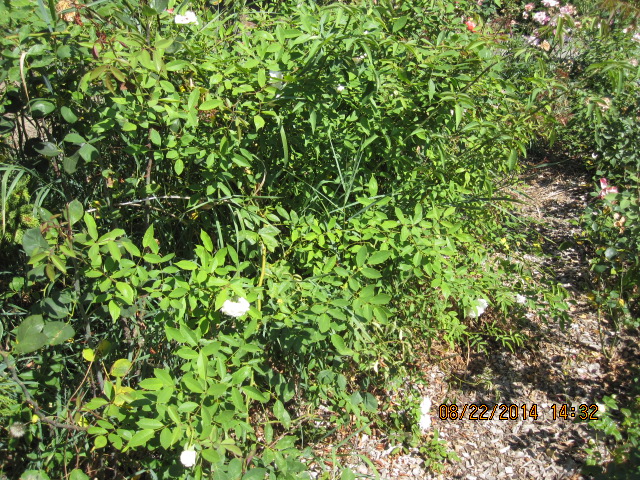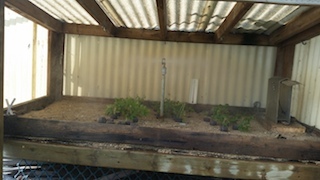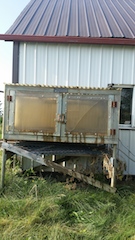I’ve been moving toward eliminating containers from my breeding program but I still have some favorites that are just too tender to pasture out. How should I go about rejuvenating these?
Why would they need rejuvenation? salt build-up, potbound, soil densification, too much top for root volume?
I kept a number of roses in pots for quite a few years, going into a small greenhouse every winter. At mid-winter if they’ve gone dormant you can prune them back, replace the soil mix and they’ll come right back when it warms up. If you have to store things buried,. or in a relatively warm dark place it is a bit harder. I have a crawl space which never goes below freezing but unfortunately it mostly is closer to 50 in a typical winter. Sprouting too early in the dark is my biggest problem.
For some of my garden roses, the hard winter actually has improved them by reducing the top/root ratio. Later bloom but more vigorous basal shoots. I think you’ll find the same with potted plants. A good pruning is beneficial, for HT/floribunda types anyway.
The soil that I take out of pots is never discarded. It goes into some kind of a garden bed for a few years to grow something else. then gets mixed with peat or compost and is used again for potting roses. We have enough rain at some seasons to leach out accumulated salts in a couple years.
Hi Don,
I always plant my breeding stock in containers. To rejuvenate the plants I repot them every 3 to 5 years. I don’t throw away the soil but amend it with peat moss, bonemeal, mushroom manure.
A good time to accomplish this task is after the first killing frost in the fall.
This is always a good time to do some root pruning and eliminating pesky weeds.
Chuckp
Those of you who use potted breeding roses, what states/hardiness zones do you live in?
When you all overwinter your roses in a greenhouse, do they get a lot of mildew? I had to constantly spray my potted roses last winter. GH was heated but the night temps were around 50 degrees for cost reasons.
Cathy
Central NJ,zone 7a
Hi Cathy,
I live on the Canadian Prairies with a z3 climate.
I don’t run my greenhouse in winter like you said it’ll be too costly. I keep my roses in a climate control room
for the winter. I normally like to bring them out in mid March.
I’m not an expert, but I think 50 deg. F is too low a temperature.
On cold spring I aim for 22 deg.C or 70deg. F at night.
chuckp
Treat them like any containerized plant and repot them.
For those who haven’t done it before (or curious as to what I do) I do the following:
Every few years (mine are on a 3 year rotation so I do 1/3 of my potted plants a year) repot them either using a bigger container or the same container either when they are still dormant or when they are just waking up. You can also do it when they are just going dormant but this may stimulate growth in a few varieties (usually the tender varieties).
I highly recommend pruning both tops and roots (especially when keeping the plant in the same sized pot). Remove as much of the loose soil (the soil on the top and edges) as you can but I do try to keep the middle of the ball as undisturbed as I can keep it. After 3 years in a pot most will have that massive collection of feeder and thicker roots at the bottom so I make sure to break that up, oftentimes eliminating some of these roots in the process. I have never seen any ill results from removing these roots but removing a portion of the top growth helps with any shock associated with this process - it can look and feel like you are being rough with the plant but it stimulates more root and top growth.
I actually don’t usually fertilize my roses and when I do it is very sporadic so I don’t have a whole lot of salt buildup in the soil from the inorganic, soluble fertilizer (maybe from other things) and I figure the watering process usually leeches any salt that might be there out of the soil anyway so when I am amending the soil I reuse the existing soil too. Usually just amend the soil by adding a composted material, peat moss (to keep light and retain moisture), some perlite (to keep loose), and some slow release fertilizer (I prefer something like bone/blood meal or other organics for potted plants - just a preference). I sometimes feel motivated enough to add a little bit of preen on top to keep any weed seeds from sprouting.
For winter storage I keep them outside. I live in Des Moines, Iowa which is zone 5b (or thereabouts) I used to dig a trench in the vegetable garden but last year I decided to skip that and just place my pots on the top surface. The pots are placed as close to one another as I can get them. I put the bigger pots on their sides and around the perimeter and the smaller ones on the inside. I then bury them under a thick layer of leaves. I had a 95+% survival of my pots last year with this method and those that died were located where the leaves had been blown off. This year I will be doing the same thing but I will be placing them on a tarp (had moles digging under them last year which made it difficult to remove them from the ground) and I will be placing a covering on top to keep the leaves from blowing off. If I want to stimulate earlier growth so I can get early blooms, I will put them on the edge and in an area I can get to easily so I can remove them and put them in the garage in late winter. Those that are early bloomers that I want to delay I like to put in the middle where the leaves will actually keep them colder longer.
So overall, I do nothing too novel or anything you didn’t know how to do already. It can take a little bit of time but it just depends on how many you have - I have over 1000 plants at the moment but that is because we will be moving next year and I am planning on not digging up too many of my roses next year.
I grow all my breeders in pots and have done so almost since I started hybridizing. In Zone 3B, a greenhouse and container-growing is pretty much a necessity in order to extend the season long enough for adequate hip ripening. Each spring, all my breeders are re-potted unless melting snow and 80F weather (for 5 days) coincide like this past spring when everything, both inside and out, sprouted overnight—then it is too late to take action and few roses were renovated this year. All my mature breeders are grown in 5 gallon pots and are stored in one of two places. I have access to a root cellar owned by an 86 year old friend–built by his father in 1918 but continually maintained and reinforced when necessary. This is the ultimate storage location for cold climates as the temperature remains in the mid to upper 30’s for most of the winter and the plants are in kept in the dark–even a small amount of light can sometimes initiate new growth. My friend will occasionally put a kerosene lantern in there at its lowest setting to keep the temperature just above freezing if the temperatures are -20F or colder outside. He does monitor conditions pretty diligently but the living plants actually help to keep the room slightly humid and the supply some heat. Prior to entering storage, all my plants are cut back by about a third or slightly more, the leaves are stripped off the plants, and the canes are tied up to maximize storage area and maintain hygiene–dead leaves are a reservoir for botyritis and other bad things. My plants are well-watered prior to entering storage and they never require additional watering through the 5-6 months of storage under these conditions. Hibernation begins around the end of October or the first week of November and the plants are removed when the snow is pretty much gone–usually mid-April but it has been earlier and also later. In most years, the plants are as clean and beautiful as the day they entered storage and I feel like I am greeting old friends. The buds are usually swelling but only a few have started to shoot (if the shoots are too long, I cut them off). I try to remove the plants in stages so some remain in the dark while I work on each group as quickly as possible. In addition to the root cellar, I also have a climate controlled, super-insulated room with a dirt floor in a garage which handles plant overflow. Because it is relatively new, I’m still working out the bugs for this type of storage but it has served me pretty well for three years–the plants are maintained at the same temperature as the root cellar by use of a milk-house heater, but the fan on the heater does cause more drying of the soil in the pots than I see in the root cellar so each plant is “watered” with a shovelful of snow once or twice during the winter on mild days. Premature shooting can occasionally occur under these conditions (the door is probably open too long for watering and that allows a bit too much light in). For some reason, the miniatures are the most prone to early growth. But any etiolated shoots grown too long in the dark are removed if necessary and I’m only occasionally dealing with once-bloomers in these conditions so it isn’t a big problem. Because the tops of the plants were cut back in the fall, top pruning is fairly minimal and this tends to minimize canker. But, once removed from storage in the spring, the root ball is cut back by about a third or slightly more. I also remove about 1.5 inches all the way around the outer edges of the root ball. All this is done with a pruning saw that is treated with alcohol between plants (I generally rotate 2 saws to allow adequate drying) and in the many years I have done this, I have seen less than a handful of plants develop crown gall. Mature plants are returned to the same container with fresh container mix added (my single largest expense). I add several tablespoons of Nutricote (6 month formula) to the fresh mix as well as a handful of organic fertilizer. The renovated plants are watered well and then supplied with an additional watering of fish emulsion to supply organisms that start breaking the organic mix. I would start the whole process earlier if I could, but the water lines to the greenhouse run from an unheated source and until the soil thaws, I can’t turn the water on as the supply lines aren’t buried that deeply. I do try to keep the freshly renovated plants out of bright sunlight for a few days until they adjust to the higher light conditions before moving them into the greenhouse-the filtered light of the head house attached to the eastern side of the greenhouse supplies pretty good conditions for this adjustment. Very rarely, I have seen a few plants suffer from extreme sun burn early in the season if placed in the greenhouse immediately. While they are waiting for their turn at renovation, I try to slow new growth down by keeping the roses outside and in a semi-shady location so they can adjust to the light conditions (and I pray for frost that is not severe). This process has served me well for years. I would also mention that what you tie the plant up with for storage can be problematic if it is of an organic nature (like some twines). If they get wet, you can have disease start under the twine–so care must be taken to keep them as dry as possible during the final watering. I like keeping the twine on the plants until the repotting process is complete–it is easier to prune the roots and handle the plants when the tops are tied. But, occasionally, a day or two of spring rain has meant I must remove the ties even if I haven’t completed renovation.
Be brave, rejuvenate in the pasture. Just dig a extra deep hole. Dirt is a real good insulator.
Or, root some cuttings and see how they do in the pasture.
Some just don’t like pots, so your tender plants could end up monsters.
The most tender roses here. Of interest because their so clean. Poor growth in pots.
Back to R an R now.


That’s funny Don, I’m thinking of doing the opposite, moving all my breeders into containers. My wife and I will probably move in the next 4 or 5 years, so I need to get all my plants into containers and ready for the move. Right now I have very few plants in containers and the ones that are, are not doing as well. So the advice on this thread is just what I need.
I think you may succeed more easily if you propagate new plants to be potted. At least they will take a while longer to out grow the pots and for the soil to deteriorate to the point of needing replenishment.
Thanks everyone for the advice.
I have a crawl space which never goes below freezing but unfortunately it mostly is closer to 50 in a typical winter.
Same here, though my space is a big insulated box that shares one wall with the house for it’s heat source. I’ve had to reduce the insulation to lower the temperature sufficiently for the plants to stay dormant.
I have over 1000 plants at the moment
I cringed at the thought of this but then I start each season with that many or more seedlings - though they get whittled down pretty quick.
But any etiolated shoots grown too long in the dark are removed if necessary
Julie, shoot elongation is more a function of temperature than light but you can eliminate the etiolation by keeping a couple of very low wattage (4 watt) LED lamps shining on the plants during storage. Only a few photons are necessary to trigger differentiation of the shoots into leaves and stems. This is now SOP for me.
I need to get all my plants into containers and ready for the move
That’s basically the reason that so many of mine were in containers. It’s a compromise that allows you to keep your breeders but adds a whole new level of support requirement.
I think you may succeed more easily if you propagate new plants to be potted.
Maybe I could do this if I were a left-coaster but here it takes three years for a cutting to become a productive breeder. Not that I’d object to this strategy, mind you, but the bigger obstacle is my lack of skill as a propagator. I admire growers in general, for their fortitude especially, but I think propagators are in a class all their own.
A low tech means to callus, root roses. In the fall stack all the pruned pieces behind a big bush out of sight and little sun. Smash down with a board and keep going till the pile is three or four feet tall. In the spring when the pile is dry enough to shred a lot of those on the bottom will have callused with roots.
HI Don,
I too struggled to make root cuttings of my seedlings.I read an article in the American Rose Society.
This is a misting system sold by Mist-A- Matic. Its self managing. Since I’m on a well system, the water quality of water is not the best. I use rain water.
The misting chamber is made from salvaged pressure treated wood and have a sand floor with heating cables running through it.
It take 6 weeks for cuttings to root.


